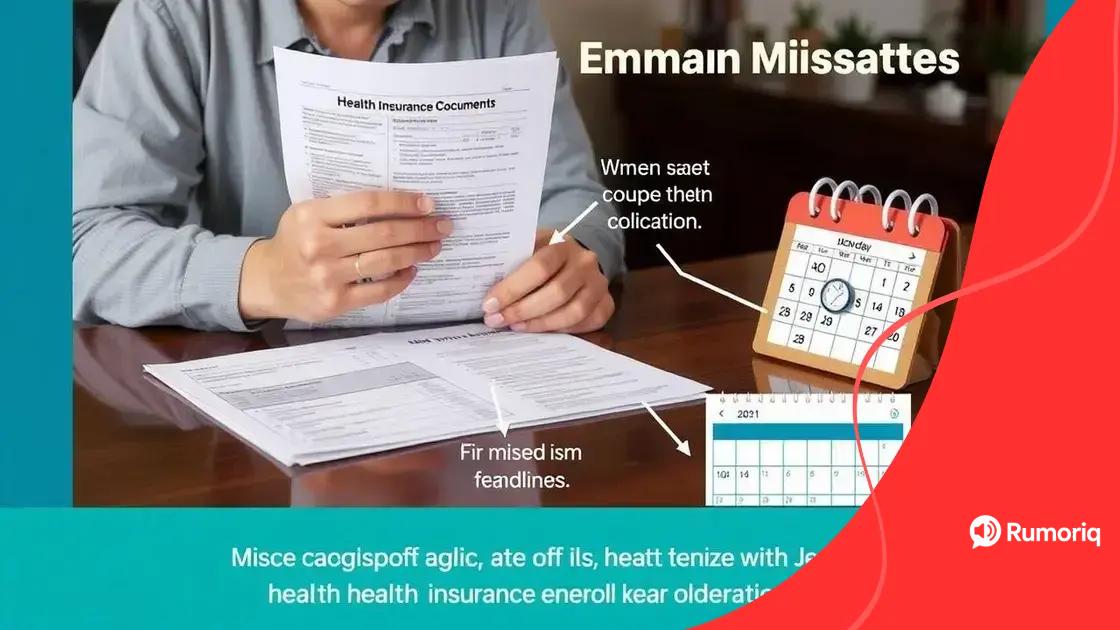Navigating open enrollment 2025: what you need to know

Anúncios
Navigating open enrollment 2025 involves understanding key dates, comparing health insurance plans, avoiding common mistakes, and recognizing the benefits of early enrollment to ensure you make informed health care decisions.
Navigating open enrollment 2025 can feel overwhelming, but it doesn’t have to be. Have you ever wondered about the best ways to choose a health plan? Let’s dive into this process together!
Anúncios
Key dates for open enrollment 2025
Knowing the key dates for open enrollment 2025 is crucial for planning your healthcare choices. With deadlines approaching, being informed can help you make the right decisions.
Important Open Enrollment Dates
The open enrollment period allows you to sign up for health insurance coverage or make changes to your existing plan. Here are the key dates to keep in mind:
- Start Date: Open enrollment typically begins on November 1, 2024.
- End Date: The period usually ends on December 15, 2024.
- Special Enrollment Period: If you miss these dates, you might qualify for a special enrollment period under certain conditions.
- Plan Selection Deadline: If you want your coverage to start by January 1, 2025, you must enroll by December 15, 2024.
In addition to these dates, it’s essential to stay updated on any changes that may arise. No one wants to miss the opportunity to get covered or to make necessary updates to their plan.
Anúncios
Remember that while the open enrollment period is specific, special circumstances can allow for enrollment outside these dates. Keep an eye out for updates from your health insurance providers!
By marking these dates on your calendar, you can ensure that you are well-prepared to navigate the process of selecting the best health insurance plan for your needs in 2025.
Understanding health insurance options
Understanding the health insurance options available to you is essential for making informed decisions. With so many choices, it’s easy to feel overwhelmed. Learning about different types of plans can help simplify the process.
Types of Health Insurance Plans
There are several types of health insurance plans available, each designed to meet different needs:
- Health Maintenance Organizations (HMOs): These plans require you to choose a primary care physician and get referrals for specialist care.
- Preferred Provider Organizations (PPOs): PPOs offer more flexibility in choosing healthcare providers and do not require referrals.
- Exclusive Provider Organizations (EPOs): EPOs combine features of HMOs and PPOs by requiring you to use in-network providers while allowing some out-of-network coverage in emergencies.
- High Deductible Health Plans (HDHPs): These plans have lower premiums but higher deductibles, often associated with Health Savings Accounts (HSAs).
Choosing the right plan means understanding your healthcare needs. If you expect to need frequent medical attention, a plan with lower out-of-pocket costs may be best. On the other hand, if you rarely visit the doctor, a high deductible plan could save you money.
Consider factors like your budget, preferred doctors, and required treatments. Knowing these details can guide you in assessing which health insurance option will work best for you. Additionally, reviewing the network of providers under each plan is a smart way to ensure your favorites are included.
Also, don’t forget to check for preventative services covered by your plan. Many health insurance options offer free check-ups, vaccinations, and screenings, which can be beneficial for maintaining your health.
Common mistakes to avoid during enrollment

Many people make common mistakes during the enrollment process that can affect their healthcare coverage. Understanding these errors can help you avoid costly outcomes.
Top Enrollment Mistakes
Here are key mistakes that individuals often make:
- Missing Deadlines: One of the most frequent errors is not keeping track of the open enrollment dates. Ensure you know when enrollment starts and ends to avoid missing your chance.
- Not Reviewing Plan Options: Many skip the step of comparing different plans. It’s vital to look at coverage details, costs, and provider networks before deciding.
- Ignoring Out-of-Pocket Costs: While premium costs are important, make sure to look at deductibles, copayments, and coinsurance. These can add up quickly and affect your budget.
- Forgetting to Update Information: If you’ve experienced life changes—like moving or changes in income—don’t forget to update your information. This can impact your eligibility and plan options.
By being aware of these mistakes, you can take control of your enrollment process. It allows you to make more informed choices, ensuring that you get the most appropriate coverage for your needs.
Avoid rushing through the enrollment process. Take the time to read all the information provided about your plan. Ask questions if you’re unsure about details. This diligence will pay off when you have the right health insurance for yourself and your family.
Remember, each year brings different choices and needs, so stay informed as best as you can. Learning from others’ errors can save you from making the same ones.
How to compare plans effectively
Comparing health insurance plans can be challenging, but it is necessary for finding the right coverage. Understanding how to compare plans effectively can save you money and ensure that you have the coverage you need.
Key Factors to Consider
When comparing different health insurance plans, focus on these key factors:
- Premiums: Check how much you will pay monthly. This cost affects your budget, so it’s essential to consider it carefully.
- Network of Providers: Ensure your preferred doctors and hospitals are included in the plan’s network. Out-of-network visits can lead to higher costs.
- Coverage Options: Look for specific coverage details of services like preventive care, prescription drugs, and specialist visits.
- Out-of-Pocket Costs: Review the deductibles, copayments, and coinsurance. Understanding these costs is important for budgeting your healthcare expenses.
Once you have this information, create a comparison chart to visualize differences between the plans. Highlight the key aspects that matter most to your health needs.
While costs are important, consider your health status and any anticipated medical needs for the upcoming year. If you expect to require more medical services, a plan with a higher premium but lower out-of-pocket costs may be beneficial.
Don’t hesitate to reach out to insurance agents or use online tools that allow you to compare plans side by side. This can provide additional clarity to your options and help you make an informed choice.
Benefits of early enrollment decisions
Making early enrollment decisions can have a significant impact on your health insurance experience. By acting sooner rather than later, you can enjoy various advantages that can enhance your coverage and reduce stress.
Top Benefits of Enrolling Early
When you choose to enroll in health insurance early, consider these benefits:
- Wider Selection of Plans: Early enrollment often gives you access to a broader range of plans. This selection allows you to choose coverage that best meets your needs.
- Less Stress: By enrolling early, you avoid the last-minute rush. This gives you time to carefully compare options without feeling overwhelmed.
- Better Understanding of Coverage: With more time, you can read through plan details, ask questions, and clarify any uncertainties before making a commitment.
- Lower Costs: In some cases, enrolling early can result in lower premiums, especially if you lock in a rate before they rise.
Early enrollment also means you are more likely to have continuous coverage. This is especially important if you have ongoing medical needs; you won’t face gaps in your healthcare access.
In addition, enrolling early can help you avoid penalties that may occur if you wait until the last minute to sign up. Knowing your options and having everything in place by the start date can give you peace of mind.
Ultimately, the earlier you decide, the better prepared you will be to handle any health issues that may arise. This proactive approach can lead to a smoother experience throughout the year.
In conclusion, navigating open enrollment 2025 effectively can lead to better health care decisions. By understanding key dates, comparing options, and avoiding common mistakes, you set yourself up for success. Remember, early enrollment offers many benefits, such as broader choices and less stress. It’s important to prioritize your health needs and make informed choices that work best for you.
FAQ – Questions about Navigating Open Enrollment 2025
What is the open enrollment period?
The open enrollment period is the time frame during which you can sign up for health insurance, typically starting on November 1 and ending on December 15.
Why is it important to compare health insurance plans?
Comparing health insurance plans helps you find the coverage that best suits your needs, budget, and preferences, ensuring you make an informed decision.
What common mistakes should I avoid during enrollment?
Common mistakes include missing deadlines, not reviewing all plan options, ignoring costs beyond premiums, and failing to update personal information.
What are the benefits of enrolling early?
Enrolling early gives you access to more plan choices, reduces stress, allows time for thorough research, and may result in lower premiums.